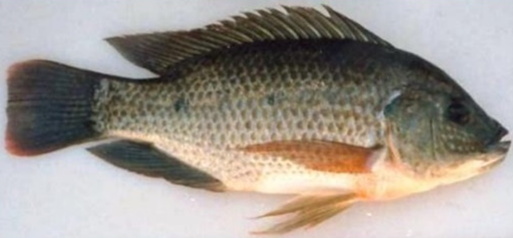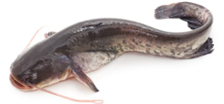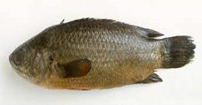IUCN/SSC Otter Specialist Group Bulletin

©IUCN/SCC Otter Specialist Group
Citation: Gowtham, R., Sharma, K. and Sathishkumar, S. (2022). Smooth-Coated Otter (Lutrogale perspicillata) Preys on Invasive Fishes in Vaduvoor Bird Sanctuary, Tamil Nadu, Southern India: Can Otters be Potential Bio-Controllers?. IUCN Otter Spec. Group Bull. 39 (2): 73 - 80
Smooth-Coated Otter (Lutrogale perspicillata) Preys on Invasive Fishes in Vaduvoor Bird Sanctuary, Tamil Nadu, Southern India: Can Otters be Potential Bio-Controllers?
Ramesh Gowtham, Kamalanathan Sharma, and Selvarasu Sathishkumar*
Department of Zoology and Wildlife Biology, A.V.C. College (Autonomous), Mayiladuthurai, Tamil Nadu, India, affiliated to Bharathidasan University, Tiruchirappalli
*Corresponding Author Email: ksathish605@gmail.com
(Received 29th August 2021, accepted 1st January 2022)
Abstract: Alien species are menacing global biological diversity by causing significant disruption of native species. The invasive fish species Pterygoplichthys sp. and Oreochromis sp. were eaten by smooth-coated otter at Vaduvoor Bird Sanctuary, Tamil Nadu. In total, six encounters were detected by both direct and indirect (corpses) observation. The invasive species play a major and important role in the smooth-coated otter’s diet. Hence, the observations showed that otter predation on invasive fish species could be as a promising potential bio-controller in inland waters and wetlands.
Keywords: Bio-controller, Lutrogale perspicillata, Invasive fish, Pterygoplichthys spp. Oreochromis spp., Vaduvoor Bird Sanctuary
INTRODUCTION
Invasive species are a threat to native species, and global biological diversity by causing significant disruption of native population and fluctuating key ecosystem processes (Pejchar and Mooney, 2009). Pterygoplichthys spp. are considered to be potential pests, with low economic value, across global fisheries (Seshagiri et al., 2021; Nico et al., 2012). They are native to the Amazon River basin of Brazil and Peru (Weber, 2003; Page and Robins, 2006). Pterygoplichthys spp. are known for bony plates covering the body, sucking lips, and a flat-bottomed body (Page and Burr, 1991), and they are common aquarium fish (Hussan et al., 2016). These invasive fish were introduced into the wild either intentionally or accidentally (Seshagiri et al., 2021; Singh, 2014). The impact of these alien species on native fish species and aquatic habitat have been recorded from several Southeast Asian countries, including Singapore, Malaysian Peninsula, Java, Sumatra, Vietnam, and Taiwan (Liang et al., 2005; Page and Robins, 2006; Levin et al., 2008), Bangladesh (Hossain et al., 2008) and India (Daniels, 2006; Krishnakumar et al., 2009; Knight, 2010; Sinha et al., 2010). They are also reported in Southern India P. multiradiatus from Kerala (Ajithkumar et al., 1998), and P. pardalis and P.disjunstivus from the Cauvery basin of Tamil Nadu (Murugan Muralidharan et al., 2015). They are now becoming a notable threat to native aquaculture and inland water ecosystem (Feroz and Preetha, 2009). Similarly, Tilapia (Oreochromis mossambicus Peters, 1852) is also an invasive fish in Indian aquaculture, native to south-eastern Africa . Bio-invasion of tilapia was reported in Lake Jaisamand, India. Tilapia is highly invasive due to high abundance and competitiveness for food and space compared to indigenous fish fauna (Ujjania et al., 2015). The Fisheries Research Committee of India had imposed a ban on tilapia propagation in 1959. In India, tilapia is competing with native, indigenous, and endemic inland freshwater fishes in terms of growth and resource utilization (Ujjania et al., 2015). This species has higher economical value, and human and animal predation are population controlling factors. O. mossambicus species is a high protein resource and is therefore
The smooth-coated otter (SCO) (Lutrogale perspicillata) is the top carnivore in wetland ecosystems (Shenoy, 2005; Khan et al., 2010). Generally, it is found in freshwater wetlands, coastal mangrove forests, riverbanks, river islands, and coastal areas. Otters are medium-sized carnivores; they are highly generalised and diverse feeders. They can prey on small mammals, reptiles, aquatic invertebrates, fishes (Lanszki et al.,2015), and birds (de la Hey, 2008). They play a vital role as an indicator of a healthy aquatic ecosystem (Ruiz-Olmo et al., 1998), balancing freshwater ecosystems (Nawab and Hussain, 2012), and especially in food webs (Roemer et al., 2009). These river sailors are apex in the riparian food pyramid (Kruuk et al., 1997) and are able to prey competently on various species belonging to both aquatic and land communities (Dey et al., 2018). The present observation documented the SCO hunting and killing invasive Pterygoplichthys and Tilapia.
Observation Area
Vaduvoor Bird Sanctuary is located at 10.42’-14.9” N and 79.19’-10.3” E, Tiruvarur district, Tamil Nadu, India (Fig. 1). The annual temperature ranges from a minimum of 26 °C to a maximum of 37° C. The mean annual rainfall is 1100 to 1260mm and the elevation is 28m. 0.42 sq.km of Vaduvoor lake is the main water resource of the 1.28 sq.km. sanctuary, which has a seasonal, highly fluctuating water level. The habitat comprises of highly patchy landscape with both aquatic and terrestrial zones, and has heterogeneous vegetation with floral species such as Acacia nilotica, Prosopis juliflora, Azadirachta indica, Pongamia pinnata, Pithecellobium dulce, Delonix regia, Sphaeranthus indicus, Momordica charantia, Ipomoea carnea, Typha angustifolia, Themenda triandra, and Pontederia crassipes. Commonly available fish species are Catla (Catla catla), Armored catfish (Pterygoplichthys pardalis), Tilapia (Oreochromis mossambicus), Catfish (Clarias batrachus), Murrel (Channa striata), Spined loach (Cobitis taenia), Common Eel (Anguilla bengalensis), and Indian Mackerel (Rastrelliger kanagurta). SCO was formally reported in the area by Arivoli and Narasimmarajan (2021). However, the forest officials had previously spotted SCO in 2018 during the synchronized bird census in the Vaduvoor lake.
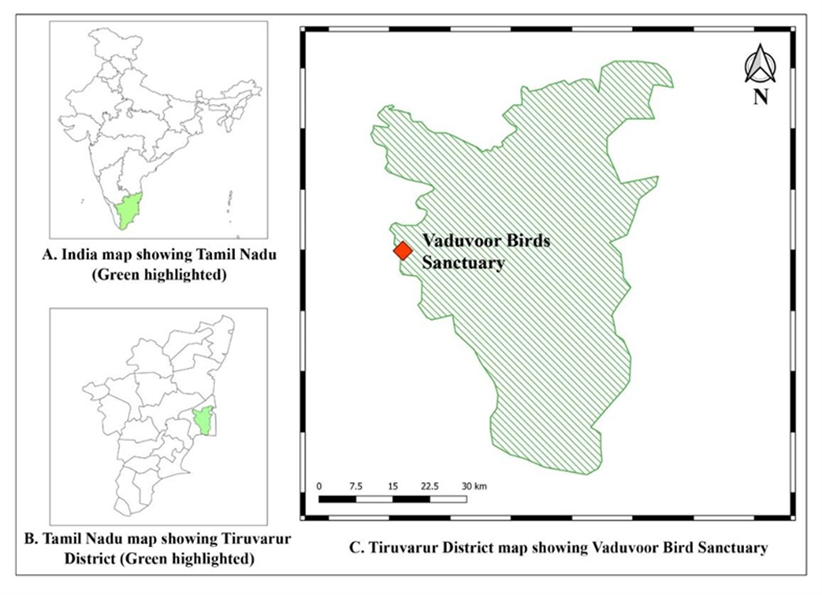
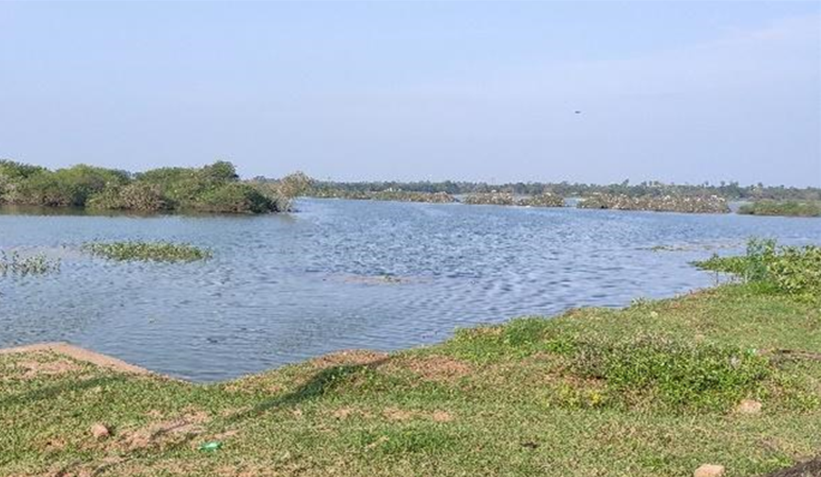
Observations
During the distribution survey in Vaduvoor bird Sanctuary, Tiruvarur, we were walking 1 km transacts along a six-kilometer stretch of lake bank, when we sighted an SCO hunting Armored catfish (P. pardalis) and Tilapia (O. mossambicus); we recorded the activity with a Canon Power Shot SX430 IS camera from the distance of ca. 100m. To understand whether SCOs often feed on such invasive fish species, we enquired of residents around the study area regarding this phenomenon. Live encounters with otters feeding on P. pardalis and O. mossambicus are counted as direct sightings, and fish remains found near the otter latrine site are considered indirect signs of otters feeding on this species.
In total in our survey at Vaduvoor Bird Sanctuary, six encounters were reported, of which three were indirect sightings and three were direct observations (Table 1). On February 18, 2021, at 17:24hr, a direct observation of feeding activity lasted for about three minutes, during which the otter first brought the hunted P. pardalis to the shore and held it in an inverted position (Fig. 2). Then it started consuming the fish from the posterior portion and ate it up to the neck region. Finally, the head region was discarded. In three indirect observations, we were found either the head portion left discarded, or a fish carcass with marks of bite marks on tail portion was found. Both direct and indirect obversvations found that the heads of the fish were discarded rather than eaten. We infer that otters do not prefer the head portion of the P. pardalis; this might because head regions do not have fleshy portions but do have a hard, bony skull. Likewise, otters were also seen feeding on O. mossambicus.
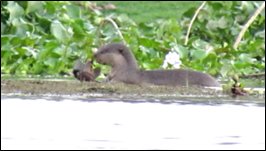
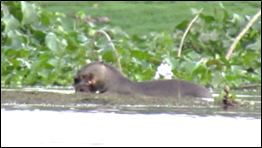

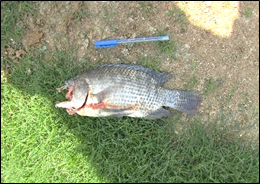
People’s Perception of Otters preying on Invasive Species
The survey was made by questionnaire to fifty selected respondents, with a small number of questions and photographs of fish found around the sanctuary (Table 2). People often visit the sanctuary for various purposes like resources utilization and livestock grazing. 60% of the people indicated that they had had live encounters and were familiar with the phenomenon of otters feeding on P. pardalis. According to these people, P. paradalis is a pest species in the Vaduvoor Bird Sanctuary. Though Tilapa is also an alien species, it has economic and nutritional value, whereas P. pardalis has no economic value and little nutrient value (Hussan et al., 2016). O. mossambicus is taken for food by local people but they consider P.pardalis as an unaesthetic “weed fish”.
DISCUSSION
Top predators usually have cascading effects on the population down to lower trophic levels in an ecosystem (Winnie and Creel, 2017). The presence of sea otters having such an influence on nearshore communities has been reported (Estes and Palmisano, 1974). A decline in predator species population makes an ecosystem disproportionately viable for dominant organisms at lower trophic levels (Weis, 2011). One reason behind the success of some invasive species is the absence of predators in the new environment. Invasive species like Pterygoplichthys spp. and Oreochromis mossambicus can make the environment more competitive and threaten the native biodiversity in absence of predation. Thus, they operate as a dominant community and use resources at faster rates than other coexisting native species. SCO are feeding preferentially on P. pardalis and this may be because of its slow mobility and easy of capture. Similarly, there are diet-based studies of other otter species that reveal feeding on this fish species. A study from the Neotropical region tells river otters’ food preference has shifted towards this fish over other prey species (Juarez-Sanchez et al., 2019). Similarly, Karunarathna et al. (2008) reported water monitor (Varanus salvator) predation on Suckermouth Catfish (Hypostomus plecostomus) in Bellanwila-Attidiya Sanctuary. Thus, the otter's diet may impact the population growth of these invaders. There is a need for continuous monitoring of otter health and ecology which can be used as a tool to indicate the health of that ecosystem. Appropriate conservation protocols should be created to encourage indigenous biodiversity. Otters do not just indicate the richness of habitat structures, but also insulate them against ecological imbalances and degradation (Goedeke and Rikoon 2008; Blanco-Garrido et al., 2008; Rheingantz et al., 2014; Okes, 2017).
Acknowledgements: We acknowledge the Tamil Nadu Forest Department, especially Mr. Syed Muzammil Abbas, IFS, the PCCF & CWW, Chennai. Dr. K. Arivoli, DFO, Thiruvarur Division, Thiuruvarur district. Mr. N.V. Jayachandran, Forest Range Officers, Mannargudi range, Thiruvarur, for granting permission and for logistic support. We also thank the management and the
Dr. R. Nagarajan, Principal and Dr. K. Chitra Priya, Assistant Professor, of A.V.C. College (Autonomous), Mannampandal, Mayiladuthurai, for the constant encouragement and support. We deeply thank Dr. Katrina Fernandez, Ecologist & Director, Wild Otters Research Pvt Ltd for her advice during the field surveys. We would like to thank Mr. Ramesh, APW, Mr. Shankar, APW, Mrs. Jothi and Mr. Srinivasan for their constant help during the field work.
REFERENCES
Ajithkumar, C.R., Biju, C.R., Thomas, R. (1998). Plecostomus multiradiatus - an armored catfish from freshwater ponds near Kunnamkulam, Kerala and its possible impact on indigenous fishes. LAK News, Limnological Association of Kerala. Wiley Black well. pp. 1-2.
Arivoli, K., Narasimmarajan, K. (2021). First Record of an Elusive Predator: The Smooth-Coated Otter (Lutrogale perspicillata) from Vaduvoor Bird Sanctuary, Thiruvarur District, Tamil Nadu, Southern India. IUCN Otter Spec. Group Bull. 38 (2): 79 – 84. https://www.iucnosgbull.org/Volume38/Arivoli_Narasimmarajan_2021.html
Blanco-Garrido, F., Prenda, J., Narvaez, M. (2008). Eurasian otter (Lutra lutra) diet and prey selection in Mediterranean streams invaded by centrarchid fishes. Springer. 10(5): 641–648.
Daniels, R.J.R. (2006). Introduced fishes: a potential threat to the native freshwater fishes of Peninsular India. Journal of the Bombay Natural History Society. 103(2 and 3): 346-348.
Dauda, A.B., Yakubu, SO., Oke, A.O. (2014). Curbing the Menace of Prolific Breeding in “Aquatic Chicken” (Tilapia): A Way out to Improve Fish Production in Nigeria. N Y Sci. J. 7(4):112-118.
de la Hey, D.C. (2008). The importance of birds in the diet of otter Lutra lutra on Shapwick Heath. Bioscience Horizons: The International Journal of Student Research, 1(2): 143–147. doi: https://doi.org/10.1093/biohorizons/hzn018
Dey, S., Choudhary, S., Kelkar, N. (2018). On the Rehabilitation of a Hand-Reared Adult Smooth-Coated Otter Lutrogale perspicillata in Bihar, India. IUCN Otter Spec. Group Bull. 35: 71-84. https://www.iucnosgbull.org/Volume35/Dey_et_al_2018.html
Estes, J.A. and Palmisano, J.F. (1974). Sea Otters: Their Role in Structuring Nearshore Communities. Science, 185: 1058 - 1060. DOI: https://doi.org/10.1126/science.185.4156.1058
Feroz Khan, M., Preetha Panikkar. (2009). Assessment of impacts of invasive fishes on the food web structure and ecosystem properties of a tropical reservoir in India. Elsevier. 220(18): 2281–2290.
Goedeke, T.L., Rikoon, S. (2008). Otters as actors: scientific controversy, dynamism of networks, and the implications of power in ecological restoration. Social Studies of Science. 38(1):111-32.
Hossain, M.Y., Rahman, M.M., Ahmed, Z.F., Ohtomi, J., Islam, A.B.M.S. (2008). First record of the South American sailfin catfish Pterygoplichthys multiradiatus in Bangladesh. Journal of Applied Ichthyology. 24: 718-720.
Hussan, A., Choudhury, T.G., Das, A., Gita, S. (2016). Suckermouth sailfin catfishes: A future threat to aquatic ecosystems of India. Aquaculture Times. 2: 20-22.
Juarez-Sanchez, D., Blake, J.G., Hellgren, E.C. (2019). Variation in Neotropical River otter (Lontra longicaudis) diet: Effects of an invasive prey species. PLoS ONE. 14(10), p.e0217727. doi https://doi.org/10.1371/journal.pone.0217727
Karunarathna, D.M.S.S., Amarasinghe, A.T., Ekanayake, E.M.K.B. (2008). Observed predation on a suckermouth catfish (Hypostomus plecostomus) by a water monitor (Varanus salvator) in Bellanwila-Attidiya Sanctuary. Biawak. 2(1): 37-39.
Khan, Waseem, Qasim, M., Ahmad, E., Chaudhry, A., Bhaagat, H., and Akhtar, M. (2010). Status of Smooth Coated Otter (Lutrogale perspicillata sindica) in Pakistan. Pakistan Journal of Zoology, 42: 817-824
Knight, J.D.M. (2010). Invasive ornamental fish: a potential threat to aquatic biodiversity in peninsular India. Journal of Threatened Taxa. 2(2): 700-704.
Kolappan, B. (2018). River otters show up in Vaduvoor lake. https://www.thehindu.com/news/national/tamil-nadu/river-otters-show-up-in-vaduvoor lake/article 25415226.ece (accessed on 10th July 2021).
Krishnakumar, K., Raghavan, R., Prasad, G., Bijukumar, A., Sekharan, M., Pereira, B., Ali, A. (2009). When pets become pests – exotic aquarium fishes and biological invasions in Kerala, India. Current Science. 97: 4-25.
Kruuk, H., Conroy, J.W.H., Webb, A. (1997). Concentrations of mercury in otters (Lutra lutra L.) in Scotland in relation to rainfall. Elsevier. 96(1): 0–18.
Lanszki J., Bauer-Haáz É.A., Széles L.G., Heltai M. (2015). Diet and feeding habits of the Eurasian otter (Lutra lutra): experiences from post mortem analysis. Mammal Study, 40:1–11. doi: https://doi.org/10.3106/041.040.0102
Levin, B.A., Phuong, P.H., Pavlov, D.S. (2008). Discovery of the Amazon sailfin catfish Pterygoplichthys pardalis (Castelnau, 1855) (Teleostei: Loricariidae) in Vietnam. Journal of Applied Ichthyology. 24: 715- 717.
Liang, S.H., Wu, H.P., Shieh, B.S. (2005). Size structure, reproductive phenology, and sex ratio of an exotic armored catfish (Liposarcus multiradiatus) in the Kaoping River of southern Taiwan. Zoological Studies. 44(2): 252-259.
Moorthy, M., Arumugam, S., Thipramalai, T.A.K. (2016). Occurrence of a Pterygoplichthys disjunctivus (Weber, 1991) population in Cauvery River System, Tamil Nadu, South India, Int. J. Fish. Aquac: 2-4.
Muralidharan, M., Manikandan, K., Gobi, M. (2015). Extended distribution of theinvasive Sucker catfish Pterygoplichthys pardalis (Pisces: Loricariidae) to Cauvery river system of Peninsular India. Int. J. Aquat. Biol. 3(1):14-18.
Nawab, A., Hussain, S.A. (2012). Prey selection by Smooth-coated otter (Lutrogale perspicillata) in response to variation in fish abundance in Upper Gangetic Plains, India. Mammalia,76: 57-65
Nico, L., Cannister, M., Neilson, M. (2012). Pterygoplichthys pardalis. USGS Nonindigenous Aquatic Species Database, Gainesville, FL.
Okes, N.C. (2017). Conservation ecology of the Cape clawless otter, Aonyx capensis, in an urban environment. (Thesis). University of Cape Town, Faculty of Science, Department of Biological Sciences.
Page, L.M., Burr, B.M. (1991). A field guide to freshwater fishes of North America north of Mexico. Peterson Field Guide Series, Houghton Mifflin Company, Boston, MA. Houghton Mifflin Harcourt. 432 p.
Page, L.M., Robins, H.R. (2006). Identification of sailfin catfishes (Teleostei: Loricaridae) in Southeastern Asia. Raffles Bulletin of Zoology. 54: 455-457.
Pejchar, L., Mooney, H. (2009). Invasive species, ecosystem services and human well-being. Trends in Ecology and Evolution. 24(9): 0–504.
Rheingantz, M.L., de Menezes, J.F.S., de Thoisy, B. (2014). Defining Neotropical otter Lontra longicaudis distribution, conservation priorities and ecological frontiers. Tropical Conservation Science. 7(2):.214-229.
Roemer, G. W., Gompper, M. E. and Valkengurgh, B. V. (2009).The ecological role of the mammalian mesocarnivore. BioScience 59:165–173.
Ruiz-Olmo, J., Delibes. M. and Zapata, S.C. (1998). External morphometry, demography and mortality of the otter Lutra lutra (Linneo, 1758) in the Iberian Peninsula. Galemys, 10: 239-251.
Seshagiri, B., Swain, S.K., Pillai, B.R., Satyavati, C., Sravanti, Y., Rangacharyulu, P.V., Rathod, R., Ratnaprakash, V. (2021). Suckermouth armoured catfish (Pterygoplichthys spp.) menace in freshwater aquaculture and natural aquatic systems in Andhra Pradesh, India. International Journal of Fisheries and Aquatic Studies. 9(1): 375-384.
Shenoy, K., Varma, S., & Prasad, K. V. D. (2006). Factors determining habitat choice of the smooth-coated otter, Lutra perspicillata, in a South Indian river system. Current Science, 91(5): 637–643.
Singh, A.K. (2014). Emerging alien species in Indian aquaculture: prospects and threats. Journal of Aquatic Biology & Fisheries. 2(1):32-41.
Sinha, R.K., Sarkar, U.K., Lakra, W.S. (2010). First record of the southern sailfin catfish, Pterygoplichthys anisistsi Eigenmann and Kennedy, 1903 (Teleostei: Loricariidae), in India. Journal of Applied Ichthyology. 26: 606-608.
Soulé, M.E., Estes, J.A., Miller, B., Honnold, D.L. (2005). Strongly interacting species: conservation policy, management, and ethics. Bioscience. 55(2), pp.168-176.
Times of India. (2019). Smooth coated otters spotted in bird count. https://timesofindia.indiatimes.com/city/trichy/smooth-coated-otters-spotted-in-bird-count/articleshow/67949442.cms (accessed on 10th July 2021).
Ujjania, N.C., Monika, D., Sharma, L.L., Vijay Kumar, B., Srivastva, R.M. (2015). Bio-invasion of exotic fish tilapia (Oreochromis mossambicus P. 1852) in Lake Jaisamand, India. International Journal of Fisheries and Aquatic Studies. 3(2): 174-177.
Weber, C. (2003). Subfamily Hypostominae (armored catfishes). In: R.E. Reis, S.O. Kullander, C.J. Ferraris, Jr. (eds.). Check List of the Freshwater Fishes of South and Central America. EDIPUCRS, Porto Alegre. 729 pp.
Weis, J.S. (2011). Invasion and predation in aquatic ecosystems. Current Zoology. 57 (5): 613−624. DOI: https://doi.org/10.1093/czoolo/57.5.613
Winnie, J.R., John, Creel, Scott. (2016). The Many Effects of Carnivores on their Prey and Their Implications for Trophic Cascades, and Ecosystem Structure and Function. FOOWEB. 3.
Résumé: La Loutre à Pelage Lisse (Lutrogale perspicillata) se nourrit de Poissons Invasifs dans le Sanctuaire des Oiseaux de Vaduvoor, au Tamil Nadu, en Inde du Sud: Les Loutres Peuvent-Elles être des Bio-Controleurs Potentiels ?
Les espèces exotiques menacent la biodiversité mondiale causant une perturbation importante des espèces indigènes. Les espèces de poissons invasifs Pterygoplichthys sp. et Oreochromis sp. ont servi de proies aux loutres à pelage lisse dans le sanctuaire des oiseaux de Vaduvoor, au Tamil Nadu. Au total, six indices de présence ont été découverts par observation directe et indirecte (cadavres). Les espèces invasives jouent un rôle majeur et important dans le régime alimentaire de la loutre à pelage lisse. En conséquence, cette observation a montré que le comportement des loutres prédatrices des espèces de poissons invasifs joue un rôle de bio-contrôleur potentiel prometteur dans les eaux intérieures et les zones humides.
Revenez au dessus
Resumen: La Nutria Lisa (Lutrogale perspicillata) depreda sobre Peces Invasores en el Santuario de Aves Vaduvoor, Tamil Nadu, Sur de India -¿Pueden las Nutrias ser Bio-Controladores Potenciales?
Las especies introducidas están amenazando a la diversidad biológica global, causando una disrupción significativa en las especies nativas. Las especies del pez invasor Pterygoplichthys spp. y Oreochromis spp. fueron comidas por la nutria lisa en el Santuario de Aves Vaduvoor, Tamil Nadu. En total, fueron detectados seis encuentros, tanto mediante observaciones directas como indirectas (carcasas). Las especies invasoras juegan un rol grande e importante en la dieta de la nutria lisa. Por lo tanto, la observación mostró que las nutrias pueden ser un prometedor bio-control potencial sobre las especies de peces invasores en aguas y humedales interiores.
Vuelva a la tapa



